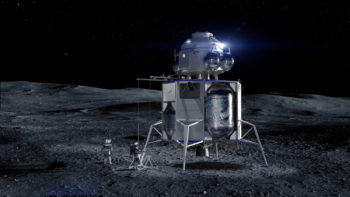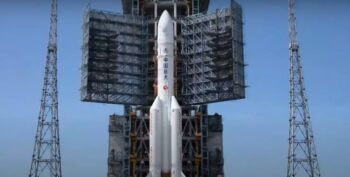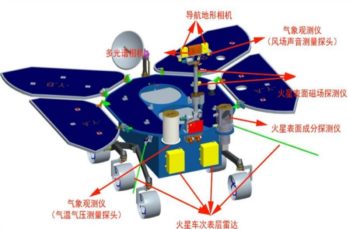Archive for July, 2020

Drill target – Mary Anning. Curiosity Right B Navigation Camera image taken on Sol 2838, July 31, 2020.
Credit: NASA/JPL-Caltech
NASA’s Curiosity Mars rover is now performing Sol 2838 tasks.
“This past week, while Curiosity has been preparing to drill its next rock target, the Perseverance rover mission has been preparing to launch to Mars,” reports Melissa Rice, a planetary geologist at Western Washington University in Bellingham, Washington.
Due to a minor issue with the rover’s arm, the drill sequence for the Mary Anning target did not execute, Rice explains, but team members expect to see the new drill hole shortly.

Curiosity Front Hazard Avoidance Camera Left B image acquired on Sol 2838, July 31, 2020.
Credit: NASA/JPL-Caltech

Curiosity Front Hazard Avoidance Camera Left B image acquired on Sol 2838, July 31, 2020.
Credit: NASA/JPL-Caltech

Curiosity Front Hazard Avoidance Camera Left B image acquired on Sol 2838, July 31, 2020.
Credit: NASA/JPL-Caltech
Re-do drill activities
“Perhaps Curiosity is just a humble, conscientious rover that did not want to steal any glory from Perseverance on its launch day,” Rice adds.
For sol 2838, the re-do of the drill activities will use most of Curiosity’s available resources, Rice adds, but there is also some time available for atmospheric monitoring activities.
“These will include a Mastcam observation of the sky to observe the high levels of dust that are expected in this season on Mars. Looking up seems like the appropriate thing to on this day, as Perseverance starts hurtling towards Mars’ skies,” Rice reports.
Launch reflections
“I have been reflecting this week about Curiosity’s launch, which was nearly nine years ago now, but still feels as vivid in my memory as yesterday. I was lucky enough to witness that launch in from the Kennedy Space Center in Florida with the Mars Science Laboratory team – I was just a graduate student at the time,” Rice notes.
“While I had only recently started collaborating on the mission, Rice says, “many of the colleagues surrounding me on the bleachers had been working tirelessly to design, build and test Curiosity for nearly a decade.”
Skyscraper full of explosives
“Imagine devoting so many years of your career to a project, and then strapping your delicate creation to a skyscraper full of explosives and pointing it towards the sky…that’s essentially what a spacecraft launch is!”
There was a palpable tension leading up to the final countdown, Rice recalls. There was pin-drop silence as the clock reached zero. “I was completely shocked at just how loud it was during liftoff. The Atlas V rocket seemed to shake the whole Earth, and I felt the sound hit my chest like a wall.”

Curiosity Mars Hand Lens Imager photo produced on Sol 2838, July 31, 2020.
Credit: NASA/JPL-Caltech/MSSS
Sensory overload
“But even more noise came from the screaming mass of scientists and engineers surrounding me,” Rice says, “who were clapping, yelling, jumping and hugging. I tried to keep my eyes on Curiosity for as long as I could, but several times I had to look away because the flames were too bright – it felt like I was staring directly at the Sun. That sensory overload just doesn’t come across when you watch a rocket launch on TV.”
For their launch, the Perseverance team stayed home to keep each other safe during the present pandemic, Rice adds, “and they watched the launch from many hundreds of individual screens. But their excitement was no less than what we felt in November 2011 – and their screams at liftoff, following that tense silence beforehand, reverberated through living rooms across the globe.”
Rice concludes: “Safe travels, Perseverance! We can’t wait for you to join us on Mars!”

Curiosity Front Hazard Avoidance Camera Left B image of “Mary Anning” taken on Sol 2834, July 26, 2020.
Credit: NASA/JPL-Caltech
NASA’s Curiosity Mars rover is just now starting to perform Sol 2836 tasks.
“A little inside joke among rover scientists, going back to previous rover missions, is the refrain ‘well, if we see a dinosaur bone, we’ll stick around,’” reports Fred Calef, a planetary geologist at NASA’s Jet Propulsion Laboratory.
While, sadly, there is (checks notes) zero chance of finding dinosaur bones on Mars, Calef adds, “our search for Martian organics is something we’re here to do!”

Curiosity Right B Navigation Camera image acquired on Sol 2833, July 26, 2020.
Credit: NASA/JPL-Caltech
Scouring the outcrop
“Following in the footsteps of the renowned paleontologist Mary Anning, we’ve been scouring the outcrop, like she did at the limestone and shale ‘Blue Lias’ cliffs in England, and today will crack the outcrop with our ‘rock hammer’ (drill) and see what mysteries are captured within,” Calef explains.
As “Keeper of the Maps,” Calef also gets to add a dot on the team’s drill targets map, which always makes his day.
Next drill sample
“After a short discussion about the results from our weekend observation on the target ‘Mary Anning,’ the science team concurred that this place is geologically similar to the ‘Glen Etive’ drill location, and would be suitable for our next drilled sample,” Calef reports.
To help characterize the pre-drill surface, the rover is slated to take a full multispectral Mastcam image of the Mary Anning, as well as a Chemistry and Camera (ChemCam) Z-stack and 5×1 observation.

Curiosity Rear Hazard Avoidance Camera Right B photo taken on Sol 2834, July 26, 2020.
Credit: NASA/JPL-Caltech
Two additional targets, “Ayton” and “Carriden,” will be observed with ChemCam and Mastcam to characterize the outcrop.
“We’ll also expand the Mastcam color imaging of the workspace in front of the rover,” Calef notes, “document two Autonomous Exploration for Gathering Increased Science (AEGIS) targets with Mastcam, and a Mars Descent Imager (MARDI) image of the surface.”
During recent science planning, Curiosity rover geologist Rebecca Williams said, “We’re drilling on Mars and launching to the red planet this week. It’s all very exciting!”
“I can’t agree more! When the new rover images come down…I hope you find some exciting things in them. And if you see a plesiosaur tail or pterosaur wing-tip, please let us know,” Calef concludes.
Dates of planned rover activities described are subject to change due to a variety of factors related to the Martian environment, communication relays and rover status.
China Academy of Space Technology has built a testing ground to prepare for China’s first Mars mission. The ground was renovated from a site which was initially used to simulate the Moon’s surface for two Chinese lunar rovers.
The testing ground comes complete with sand and stones to simulate various scenes on Mars surface.
Rover modes
As explained in a CCTV-Plus video, staff members used silicon carbides on the Earth, and washed them with water to make sure they are clean enough.
“On this site, we mainly test all its working modes. We tested normal working mode and also its malfunction mode to see how it gets out of trouble when malfunction occurred. In fact, our testing ground served as an examination room before the final launch mission,” said Jia Yong, an expert of China Aerospace Science and Technology Corporation.
China’s Mars rover is very similar to the country’s lunar rovers, but larger in size.
“We must improve the autonomy of the rover. Besides, the environmental conditions of the Mars surface are probably more complicated than the Moon. A result we can directly perceive through the eyes is that the rover is moving sideways, just like a crab, a feat the lunar rover incapable of,” Teng Baoyi, deputy chief designer of China Aerospace Science and Technology Corporation, in the CCTV-Plus interview.
Difficult mission
In a related interview with CCTV, Liu Tongjie, deputy director of the Lunar Exploration and Space Program Center under the China National Space Administration (CNSA) said the Tianwen-1 mission – consisting of an orbiter, lander and a rover — is extremely difficult.
The spacecraft is expected to enter Mars orbit around February 2021. Afterwards, it will spend two to three months surveying potential landing sites by using a high-resolution camera to prepare for the landing in May.

In a post-launch press conference, Liu Tongjie, spotlighted the southern part of the Utopia Planitia as the Tianwen-1 landing zone.
The Tianwen-1 orbiter carries with it seven science instruments while the rover carries six.
When the probe arrives in February next year, “we will not let it land on the surface of the Mars immediately. First, we will let it carry out some preliminary explorations on the orbit of the Mars, making some trial operations and explorations. Then we will find a better window for it to make its landing into the atmosphere of the Mars,” said Liu.
Northern hemisphere
The landing spot for the probe was carefully picked in accordance with the terrain of Mars.
“From what we’ve learned so far, the southern hemisphere of Mars is mountainous, while more plains are seen on the northern hemisphere. So we choose to make the landing on the latter. Right now we’ve picked the Utopia Planitia,” Liu said.
Mars sample return
After the landing, the rover will be released to conduct scientific exploration with an expected lifespan of at least 90 Martian days (about three months on Earth), and the orbiter, with a design life of one Martian year (about 687 days on Earth), will relay communications for the rover while conducting its own scientific tasks.
As reported by the China Global Television Network (CGTN) China officials have suggested that if the Tianwen-1 and later this year the Chang’e-5 Moon sample return mission go well, China could attempt to return samples from Mars beginning around 2030.
Also go to this XinhuaVideo on what science tasks China’s Mars mission is to carry out, focused on what the surface of Mars is made of.
Go to:

China’s three-in-one mission: An orbiter, lander, and rover.
Credit: Wan, W.X., Wang, C., Li, C.L. et al.
Now en route to Mars is China’s Tianwen-1 probe. Joining that long march to the Red Planet is the United Arab Emirates (UAE) Hope orbiter. Lastly, NASA’s Perseverance rover is ready for sendoff on July 30th.
In readying this trio of spacecraft, engineers and test technicians endured the COVID-19 crisis. Indeed, the pandemic greatly complicated each spacecraft’s journey to their respective launch pads.
Forward contamination
Is there any worry about sending the coronavirus to the surface of Mars?
Even the UAE’s orbiter could experience a troubled insertion into Mars orbit, plowing into the Red Planet – Earth to Mars forward contamination.
For an answer, I asked noted astrobiologist, Penny Boston, Senior Advisor for Science Integration at NASA’s Ames Research Center.
Viruses are fragile
“COVID 19 is a virus. It only infects the cells of mammals or birds, as is true of all coronaviruses. To my knowledge, no mammals or birds are currently on their way to Mars…or about to be on their way to Mars. Viruses don’t successfully hang out in rocks or etc., they require living hosts. Viruses are far more fragile than bacteria, not to mention extremophile bacteria,” Boston responded.
“The ionizing radiation environment of the Martian surface will be highly effective at ripping apart the puny single stranded RNA of Covid-19 with its thin protein coat,” Boston added. “Ionizing radiation will thoroughly penetrate through all of the spacecraft on Mars or going to Mars. Therefore, there is essentially a zero chance of viruses remaining intact in the Mars environment, including on the inside of spacecraft.”
In this Arms Control and International Security (ACIS) paper, Christopher Ashley Ford, Assistant Secretary for International Security and Nonproliferation discusses his long-standing efforts to find effective forms of arms control in outer space.
Future prospects
The paper also offers the reasons such efforts have failed in the modern era, before exploring what prospects there yet may be for international efforts to reduce risk, increase transparency and predictability, and head off the dangers of an outer space arms race.

A highly modified F-15A scored a direct hit on a U.S. satellite in this Sept. 13, 1985 test shot over Edwards Air Force Base, California.
Credit: Edwards Air Force Base
This series paper characterizes both the Russian federation and the People’s Republic of China (PRC) as rushing to weaponize the space domain.
The Papers are produced by the Office of the Under Secretary of State for Arms Control and International Security.
To access the July 24, 2020 paper — Arms Control in Outer Space: History and Prospects – go to:
Also, go to this special briefing by Christopher A. Ford on the U.S.-Russia Space Security Exchange at:

Image of layered block named “Mary Anning” — possible next drill target — taken by Curiosity’s Left Navigation Camera on Sol 2829.
Credit: NASA/JPL-Caltech.
NASA’s Curiosity Mars rover is now carrying out Sol 2832 tasks.

Curiosity Front Hazard Avoidance Camera Right B image taken on Sol 2831, July 23, 2020.
Credit: NASA/JPL-Caltech
Reports Michelle Minitti, a planetary geologist at Framework in Silver Spring, Maryland: “Our drive in the last plan successfully placed at what we hope is our next drill site, the large, lovely, layered block. (photo at left). It is always exciting to name a new drill target, but the new name, ‘Mary Anning,’ is particularly special.
Minitti explains that Mary Anning spent her life scouring the seaside cliffs near Lyme Regis, along the southern coast of England, for fossils. “She uncovered innumerable samples, most notably the first full Ichthyosaur and the first Plesiosaur.”
But as all too often occurs in society, Minitti adds, “Mary Anning’s gender and societal status led her groundbreaking work and discoveries to be dismissed by the scientific establishment or, worse, appropriated by men. Let Mary Anning’s name on Mars remind us to include everyone in the endeavor of exploration.”
Drilling next week
Curiosity Mars teams have played a role in planning the five sols that will accomplish the work necessary to attempt drilling next week, Minitti notes.
The robot’s Chemistry and Camera (ChemCam) will measure the chemistry of both the primary and back up Mary Anning drill targets, in addition to “Carter Fell,” another target on the large bedrock slab the rover will drill.

Curiosity Chemistry & Camera Remote Micro-Imager (RMI) photo acquired on Sol 2831, July 23, 2020.
Credit: NASA/JPL-Caltech/LANL
Gauge its hardness
The Alpha Particle X-Ray Spectrometer (APXS) will also analyze the chemistry of the primary Mary Anning target, the Mars Hand Lens Imager (MAHLI) will image the target in detail, and then rover planners will push the drill bit into the drill target to gauge its hardness and test its ability to withstand the force of the drill activity.
Imaging of region

Curiosity Right B Navigation Camera photo taken on Sol 2831, July 23, 2020.
Credit: NASA/JPL-CaltechImaging of region
“Mastcam will acquire a 360 degree panoramic mosaic of our surroundings, which documents the context of our drill location within the Glen Torridon region and facilitates planning for more detailed imaging of the region,” Minitti reports. “Since the workspace is obviously of interest, Mastcam will also acquire a detailed stereo mosaic that covers the workspace.”
Curiosity’s Chemistry & Mineralogy X-Ray Diffraction/X-Ray Fluorescence Instrument (CheMin) will conduct an empty cell analysis, Minitti adds, and the Sample Analysis at Mars (SAM) Instrument Suite will test out analysis techniques, each in preparation for analyzing the next drill sample.
Skyward looks
“Even as our attention is drawn to the rocks around us, dust storm season swirls about Curiosity, warranting our attention on the skies as well. ChemCam will turn its spectrometers skyward in passive mode to observe a wide area of the sky in order to measure concentrations of minor gases (especially oxygen and water) and dust,” Minitti points out.
Combinations of Navcam and Mastcam will monitor the amount of dust in the atmosphere early in the morning, around midday, and later in the afternoon; Navcam will also look for dust devils around midday and clouds early in the morning.
Long plan
Also on tap, the Radiation Assessment Detector (RAD) and the Dynamic Albedo of Neutrons (DAN) are slated to make dozens of measurements across four sols.
The rover’s Rover Environmental Monitoring Station (REMS) will make regular measurements of Martian weather conditions throughout the plan, Minitti concludes. “It is the lone star of the show on the final sol of the plan, dutifully working away as the rest of the instruments take a much needed break at the end of the long plan.”
The White House National Space Council has released a report on Deep Space Exploration and Development in consultation with the Council’s members and its Users’ Advisory Group. It describes the rationale and purpose for the Administration’s new direction in space.
Whole of government approach
“‘A New Era for Deep Space Exploration and Development’ represents a comprehensive, whole-of-government approach to this Administration’s ambitious space exploration efforts, providing a vision for a sustained human presence on, and the robust commercial development of, the Moon and Mars,” said Executive Secretary of the National Space Council, Scott Pace.
“This report describes how and why the United States will proceed with deep space exploration,” Pace adds in a press statement, “delineating the strategic interests and specific programs that underpin America’s position as the world’s leader among spacefaring nation.”
Report highlights
The newly issued report delves into the commercialization of low-Earth orbit; returning to the Moon to stay; extending a human presence to Mars; the potential for deep space science; and education and the U.S. workforce.
The success of American space exploration and development in this new era, the report stresses, will require a whole-of-government approach.
Five primary government roles are crucial to executing the vision described in the report:
— Promote a secure and predictable space environment for the long-term sustainability of space activities;
— Support the development of commercial activity and industry in space;
— Support research and development of new space technologies;
— With commercial and international partners, create infrastructure needed for space exploration and development; and
— Support advanced space research by public and private sector U.S. research communities.
Commercial firms
The report explains that, “as soon as possible, and in accordance with the
Executive Order on “Encouraging International Support for the Recovery and Use of Space Resources”, commercial firms should take over routine operations to provide consumables like water, hydrogen, oxygen, and utilities such as power and communications. The transition to private sector responsibilities will represent an important step beyond space exploration to development and industrialization.”
International partners
“As the United States journeys into deep space again,” the report explains, “it will do so with commercial and international partners as they are willing to participate and capable of participating.”
“At the frontiers of exploration, the United States will continue to lead, as it has always done, in space. If humanity does have a future in space, it should be one in which space is the home of free people,” the report concludes.
For the full report, go to:

A Long March-5 Y4 rocket departs from the Wenchang spacecraft launch site on the coast of southern China’s island province of Hainan.
Credit: CCTV/Inside Outer Space screengrab
China’s Mars mission Tianwen-1 is now en route for a targeted landing in May 2021, reportedly within the southern part of the Utopia Planitia – a relatively flat area selected for a safe touchdown spot and for scientific payoff.
The Mars mission is an all-in-one attempt to orbit the Red Planet, dispatch a lander that will then release a six-wheel solar-powered rover.
Seven-month sojourn
A Long March-5 Y4 rocket, China’s largest launch vehicle, lofted the spacecraft with a mass of about 5 tons on July 23 from the Wenchang Spacecraft Launch Site on the coast of southern China’s island province of Hainan at 12:41 p.m. (Beijing Time).

Outbound for Mars. Image of the release of China’s Tianwen-1 spacecraft.
Credit: CCTV/Inside Outer Space screengrab
About 36 minutes later, the Tianwen-1 spacecraft was sent into the Earth-Mars transfer orbit, embarking on a nearly seven-month sojourn to the Red Planet, according to the China National Space Administration (CNSA).
The craft is expected to enter the orbit of Mars around February 2021. Afterwards, it will spend two to three months surveying select landing sites using a high-resolution camera to prepare for the landing in May.
Orbiter, rover
China’s Xinhua news agency reports that, after the landing, the rover will be released to conduct scientific exploration with an expected lifespan of at least 90 Martian days (about three months on Earth), and the orbiter, with a design life of one Martian year (about 687 days on Earth), will relay communications for the rover while conducting its own scientific tasks.
Chinese space engineers and scientists have chosen a relatively flat region in the southern part of the Utopia Planitia, a large plain, as the potential landing zone. Earlier research suggests that this region may be an underground, water ice-rich zone. This possible site might be at the edge of an ancient ocean or lake in the early history of Mars.
“The reason we selected this place is that it has both the conditions for a safe landing and scientific research value. The place has not been investigated by other countries, so the scientific data can be shared with other countries to enrich the world’s understanding of Mars,” Geng Yan, an official at the Lunar Exploration and Space Program Center of the CNSA, reports Xinhua.

In a post-launch press conference, Liu Tongjie, spotlighted the southern part of the Utopia Planitia as the Tianwen-1 landing zone.
Transfer-orbit
Zhang Xueyu, commander of launching site headquarters of the Mars probe mission, declared the success of the launch mission. “As the information from the Aerospace Flight Control Center indicates, the Long March-5 Y4 rocket is flying normally. The Mars probe has accurately entered the orbit. Now I declare a complete success of the launch mission of China’s first Mars probe,” he said.
China’s CCTV noted the remarks of He Rongwei, chief commander of the Mars probe mission from the China Academy of Space Technology (CAST).
“The rocket performs very well and targets accurately, which has sent the Mars probe into the Earth-Mars transfer orbit precisely,” He said. “It should be said that our first Mars probe has a perfect start.”
Tracking ships
Meanwhile, three space tracking ships of China’s Yuanwang fleet completed maritime monitoring of the country’s first Mars probe launch in the Pacific Ocean Thursday.
Xinhua reports that about six minutes after the liftoff, the Yuanwang-6 tracking ship detected and locked onto its targets, and carried out measuring of the rocket, and control and monitoring of the Mars spacecraft. The other two tracking ships, Yuanwang-5 and Yuanwang-7, then took turns to complete their missions.
The monitoring process lasted nearly 30 minutes.
As scheduled, Xinhua reports, the Yuanwang-5 and Yuanwang-7 tracking ships will return to China, while Yuanwang-6 will sail to its next mission area for satellite monitoring.
Go to these China Central Television (CCTV) videos that detail the launch and mission of Tianwen-1:
https://youtu.be/LC9CDUK660c?list=PLpGTA7wMEDFjz0Zx93ifOsi92FwylSAS3
China’s first Mars exploration mission, known as “Tianwen-1” appears to have a targeted Thursday liftoff expected between just after midnight and 3 a.m. Eastern Daylight Time, assuming the weather cooperates.
Meanwhile, more details on China’s Mars rover have been reported.
The rover will work for over 90 days on Mars. The robot is equipped with a 2 foot (60 centimeters)-high mast that supports two panorama cameras on its top to avoid obstacles when moving forward, as well as a multispectral camera to identify minerals.
Tilting solar panels
China’s Mars rover also has four “wings” – solar panels to provide power. The rover can adjust the angles of its solar panels to receive more solar power, according to Liu Tongjie, deputy director of the Moon Exploration and Space Engineering Center of the China National Space Administration (CNSA).

Liu Tongjie, deputy director of the Moon Exploration and Space Engineering Center of the China National Space Administration (CNSA).
Credit: CCTV/Inside Outer Space screengrab
“As Mars receives less solar energy than the Earth and the Moon, the area [of its solar panels] is larger. It can angle its solar panels according to the direction of the sunlight. The more vertical the angle is, the more solar energy it will receive,” Liu told China Central Television (CCTV).
Other instruments onboard include a detection radar, magnetometer and meteorological instruments.
Subsurface studies
The Red Planet rover can detect the ingredients of soil 33 feet (10 meters) underneath the surface of Mars and of ice 328 feet (100 meters) below the surface.
The rover can move at a speed of 200 meters per hour on Mars’ surface.
Liu said the thin atmosphere of the Mars poses challenges to the rover and the landing platform during their landing process.
Landing process
“The density of the Mars atmosphere is relatively low. It is equivalent to one percent of the Earth’s standard atmosphere. So we have to equip the landing platform with parachutes, which is more complex and difficult,” said Liu.
The landing process takes only seven to eight minutes. During this period, the landing platform can only rely on itself, Liu explained.
Why do humans want to explore Mars?
Go to this informative video at:
NASA’s Curiosity Mars rover is now performing Sol 2830 tasks.
Reports Ryan Anderson, Planetary Geologist at USGS Astrogeology Science Center in Flagstaff, Arizona: “Our weekend observations of the target Breamish showed some interesting chemistry results (which always make our scientists exclaim “O frabjous day! Callooh! Callay!”)”
The plan on Sol 2829 was set to start off with some follow up observations: The robot’s Mastcam will take a multispectral image of Breamish, and its Chemistry and Camera (ChemCam) will analyze it a second time.
“Mastcam will document the repeat observation of Breamish as well as the autonomously selected ChemCam targets from the weekend,” Anderson adds. Mastcam will also take a mosaic of an interesting cross-bedded block named “Mercat Cross.”
Expected drill location
In the afternoon of Sol 2829, the plan called for a short drive or “bump” to an expected drill location called “Mozie Law.”
From that new location, the plan called for collecting the usual post drive images, including a Mars Descent Imager (MARDI) image of the ground beneath the rover and a Mastcam “clast survey” image of the ground nearby.
Calibration target
On Sol 2830, the plan tags Curiosity’s ChemCam to analyze two computer-selected rock targets and Navcam will take a look at the rover deck.

Curiosity Front Hazard Avoidance Camera Right B image acquired on Sol 2829, July 21, 2020.
Credit: NASA/JPL-Caltech
“Mastcam will look at the Sun to measure the dust in the atmosphere, and the plan will wrap up with a late afternoon ChemCam measurement of the titanium calibration target on the rover to monitor temperature-related changes in the signal,” Anderson reports.
As always, dates of planned rover activities are subject to change due to a variety of factors related to the Martian environment, communication relays and rover status.









































